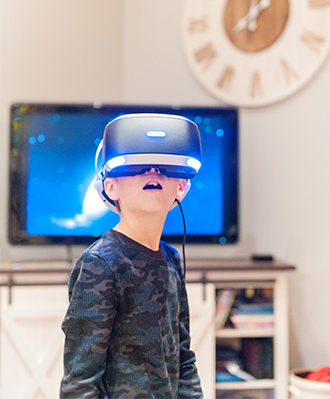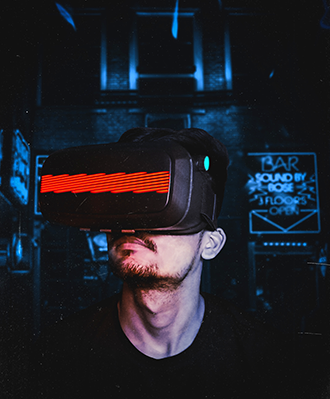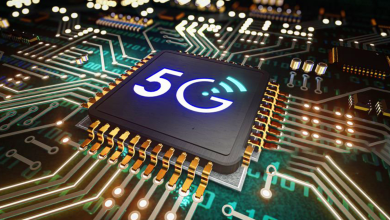Exploring the Future of Immersive Technology Virtual Reality and Augmented Reality
Future of Immersive Technology

Exploring the Future of Immersive Technology: Virtual Reality (VR) and Augmented Reality (AR)
Introduction
In a world constantly seeking innovation, two transformative technologies have emerged to redefine the way we interact with digital content and experience the world around us: Virtual Reality (VR) and Augmented Reality (AR). These immersive technologies offer exciting possibilities across various industries, from gaming and entertainment to education, healthcare, and beyond. In this article, we will delve into the fascinating world of VR and AR, exploring their differences, applications, and the potential impact on our daily lives.

-
Understanding Virtual Reality (VR)
Future of Immersive Technology Virtual Reality, often abbreviated as VR, is a technology that creates a simulated environment, allowing users to immerse themselves in a different reality. By wearing a VR headset, users can shut out the physical world and enter a computer-generated one. This virtual world is typically three-dimensional and interactive, responding to the user’s movements and actions. VR has gained substantial attention in recent years, primarily due to its impressive capabilities and applications.
-
How VR Works
At the core of VR lies the immersive nature of the experience, which is achieved through a combination of  hardware and software. VR headsets, like the Oculus Rift, HTC Vive, or PlayStation VR, are equipped with high-resolution displays that are placed close to the eyes, providing a stereoscopic view. Sensors within the headset track the user’s head movements, ensuring that the virtual environment aligns with the user’s perspective in real-time. Additionally, motion controllers or gloves allow users to interact with the virtual world, enhancing the sense of presence.
hardware and software. VR headsets, like the Oculus Rift, HTC Vive, or PlayStation VR, are equipped with high-resolution displays that are placed close to the eyes, providing a stereoscopic view. Sensors within the headset track the user’s head movements, ensuring that the virtual environment aligns with the user’s perspective in real-time. Additionally, motion controllers or gloves allow users to interact with the virtual world, enhancing the sense of presence.
-
VR Applications
VR’s applications span a wide range of industries:
- Gaming: VR gaming is a major driver of the technology’s popularity. Gamers can immerse themselves in stunning virtual worlds, interact with characters, and experience games in an entirely new way.
- Education and Training: VR is a powerful tool for education and training, allowing students to explore historical sites, simulate science experiments, and provide immersive training scenarios for professionals in various fields, from healthcare to aviation.
- Healthcare: VR is used for therapy, rehabilitation, and pain management. It can also simulate complex medical procedures for training purposes.
- Architecture and Design: Architects and designers use VR to create and visualize 3D models, allowing clients to step into their designs before construction begins.
- Virtual Tourism: VR enables people to explore distant destinations without leaving their homes, offering a new dimension of travel.
- Social Interaction: Social VR platforms like VRChat and AltspaceVR allow users to meet, communicate, and engage in various activities with people from around the world in virtual environments.
- Augmented Reality (AR) Unveiled
Future of Immersive Technology Unlike VR, which immerses users in a completely digital environment, Augmented Reality (AR) overlays digital elements onto the physical world. AR enhances our perception of reality by adding information, visuals, or interactivity to the world we see around us, often through smartphones, smart glasses, or headsets. AR technology has made significant strides in recent years, and its applications are both diverse and promising.
-
How AR Works
AR functions by combining real-world input with computer-generated data. It leverages sensors, cameras, and processors to recognize and track objects in the user’s environment. The AR device, such as a smartphone, displays digital content on its screen, integrating it with the real-world view. Users can interact with the augmented elements and receive information in real-time.

-
AR Applications
AR is applied in a variety of fields:
- Navigation and Wayfinding: AR navigation apps like Google Maps offer real-time directions and information overlaid on the user’s view of the physical world, making navigation more intuitive.
- Retail and Commerce: AR is used for virtual try-ons, where users can see how products will look before purchasing, and it also offers interactive product information and promotions.
- Education: AR apps can enhance learning by bringing educational materials to life, such as 3D models, historical reenactments, and interactive textbooks.
- Healthcare: AR is employed in medical procedures, allowing surgeons to view patient data and surgical plans in their field of vision. It can also assist in remote consultations and training.
- Entertainment: AR games like Pokémon GO have gained immense popularity, encouraging players to explore the real world while interacting with virtual elements.
- Industrial and Manufacturing: AR is used for remote assistance, equipment maintenance, and quality control by providing real-time information and instructions to workers on the factory floor.
III. The Differences Between Future of Immersive Technology VR and AR
While VR and AR share the common goal of enhancing our digital experiences, they have distinct differences:
- Immersion Level: VR provides a high level of immersion by completely replacing the real world with a virtual one. In contrast, AR supplements the real world with digital elements while allowing users to remain aware of their surroundings.
- Hardware Requirements: VR typically requires specialized headsets to create immersive experiences, while AR can often be accessed through more common devices, such as smartphones and tablets.
- Use Cases: VR is well-suited for applications that benefit from full immersion, such as gaming and simulation. AR is more practical when users need to interact with the real world simultaneously, like navigation or educational tools.
- Social Interaction: While both VR and AR have social applications, VR places users in a shared virtual space, while AR overlays digital information onto the real world, making it easier to maintain real-world social interactions.

-
The Future of VR and AR
The future of Future of Immersive Technology VR and AR is undeniably exciting. These technologies are continually evolving, pushing the boundaries of what’s possible and influencing multiple aspects of our lives.
- Integration of VR and AR: In the coming years, we can expect the lines between VR and AR to blur. Mixed Reality (MR) is an emerging concept that combines the best of both worlds, allowing users to seamlessly transition between fully virtual and augmented experiences. This could lead to a single device that serves both purposes.
- Improved Hardware: VR and AR hardware will become more accessible and user-friendly. Headsets will become lighter, more affordable, and wireless, making them more practical for everyday use.
- Education and Training: VR and AR will revolutionize education and training. Students will have access to immersive experiences that were once limited to expensive equipment or locations. Healthcare professionals, first responders, and military personnel will undergo realistic training in virtual environments.
- Healthcare and Therapy: The medical field will increasingly use VR and AR for patient diagnosis, treatment, and therapy. For example, AR could assist surgeons during complex procedures, while VR could provide therapeutic environments for mental health treatments.
- Entertainment and Social Interaction: The entertainment industry will continue to benefit from immersive experiences, with VR and AR becoming integral to gaming, live events, and social interaction. The boundaries of creativity in storytelling and content delivery will be pushed even further.
- Augmented Workspaces: AR will transform the way we work, making information and data more accessible in the office, on the factory floor, and during remote collaboration. This will boost productivity and streamline decision-making processes.
Conclusion
Future of Immersive Technology VR) and Augmented Reality (AR) have taken the world by storm, offering transformative experiences that span various industries. VR immerses users in entirely virtual environments, while AR augments the real world with digital information and interactivity. The differences between these technologies create unique opportunities and applications.
As we look ahead, the convergence of VR and AR, the enhancement of hardware,





